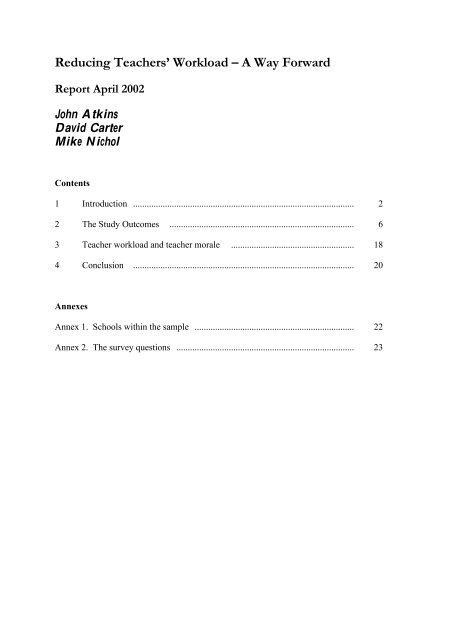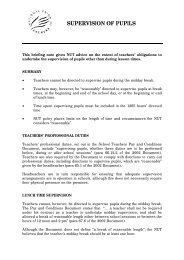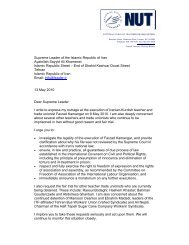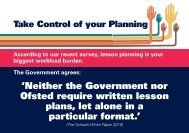Reducing Teachers' Workload â A Way Forward - National Union of ...
Reducing Teachers' Workload â A Way Forward - National Union of ...
Reducing Teachers' Workload â A Way Forward - National Union of ...
Create successful ePaper yourself
Turn your PDF publications into a flip-book with our unique Google optimized e-Paper software.
<strong>Reducing</strong> Teachers’ <strong>Workload</strong> – A <strong>Way</strong> <strong>Forward</strong><br />
Report April 2002<br />
John Atkins<br />
David Carter<br />
Mike Nichol<br />
Contents<br />
1 Introduction ................................................................................................. 2<br />
2 The Study Outcomes ................................................................................. 6<br />
3 Teacher workload and teacher morale ...................................................... 18<br />
4 Conclusion ................................................................................................. 20<br />
Annexes<br />
Annex 1. Schools within the sample ...................................................................... 22<br />
Annex 2. The survey questions .............................................................................. 23
1 Introduction<br />
The background to this study<br />
For some years now, teachers in England and Wales have been expressing increasing concern<br />
over the workload level required <strong>of</strong> them, and over the impact their workload level is having<br />
on their pr<strong>of</strong>essional and private lives. A number <strong>of</strong> projects, mainly under the “reducing<br />
bureaucratic burdens” label, have been addressed at mitigating teacher workloads at the<br />
systemic level. In particular, a major study by PricewaterhouseCoopers, carried out through<br />
2001, has provided Government with valuable data on the workloads teachers in England and<br />
Wales currently face.<br />
However, pr<strong>of</strong>essional associations have also been pressing Government to implement a new<br />
contract for teachers which includes some assurances at the level <strong>of</strong> the individual teacher<br />
that workloads can be moderated.<br />
Parallel developments in Scotland<br />
Meanwhile, parallel developments have been proceeding in Scotland. In September 1999 the<br />
Scottish Parliament set up a Committee <strong>of</strong> Inquiry into Pr<strong>of</strong>essional Conditions <strong>of</strong> Service for<br />
Teachers (the “McCrone Committee”), which reported in May 2000. The agreement adopted<br />
by the employers, the pr<strong>of</strong>essional associations and Government in Scotland in January 2001<br />
provided for:<br />
• the formal introduction <strong>of</strong> a 35 hour week for all teachers from 1 August 2001<br />
• a phased reduction in maximum class contact time to 22_ hours per week equalised<br />
across the primary, secondary and special sectors<br />
• during the phasing period, the class contact commitment <strong>of</strong> a teacher will be<br />
complemented by an allowance <strong>of</strong> personal time for preparation and correction: the<br />
allowance will be no less than one third <strong>of</strong> the teacher’s actual class contact<br />
commitment<br />
• all tasks which do not require the teacher to be on the school premises can be carried<br />
out at a time and place <strong>of</strong> the teacher’s choosing: teachers will notify the appropriate<br />
manager <strong>of</strong> their intention in this respect; and<br />
• from August 2006, at the earliest, the contractual obligations <strong>of</strong> teachers will be<br />
expressed in relation solely to a 35 hour week within which a maximum <strong>of</strong> 22_ hours<br />
will be devoted to class contact.<br />
The 2002/03 negotiations<br />
As a result <strong>of</strong> these developments, it is now looking increasingly likely that the current round<br />
<strong>of</strong> deliberations by the School Teachers’ Review Body [STRB] will lead to such<br />
recommendations on workload being made to the Secretary <strong>of</strong> State for Education. The<br />
Secretary <strong>of</strong> State herself has expressed sympathy with the workload issues faced by teachers.<br />
However, there has remained some doubt about what teachers themselves actually think<br />
NUT/ATL 2 <strong>Reducing</strong> Teacher’s <strong>Workload</strong>
about their workloads, and what steps they believe should be taken to reduce the burdens on<br />
them.<br />
The Implementation Report<br />
In order to address this doubt, the <strong>National</strong> <strong>Union</strong> <strong>of</strong> Teachers [NUT] commissioned John<br />
Atkins, one <strong>of</strong> the authors <strong>of</strong> this Report, to carry out a brief study <strong>of</strong> the implementation <strong>of</strong><br />
McCrone in Scotland, and report on how a similar agreement might be framed in England.<br />
This report (the “Implementation Report”) was submitted to the NUT, and by them to the<br />
STRB, in late 2001. 1 It demonstrated that the McCrone approach could work in Scotland,<br />
given sufficient goodwill from all parties, and provided an effective way to mitigate teacher<br />
workload within the proposed framework <strong>of</strong> Scottish legislation and regulation.<br />
Since however the employment context for teachers in England and Wales is different – for<br />
example the contractual limit <strong>of</strong> 1265 hours “directed time” had no direct equivalent in<br />
Scotland pre-McCrone – the fieldwork for the Implementation Report also included visits to a<br />
small number <strong>of</strong> schools in England. As a result <strong>of</strong> these visits, and <strong>of</strong> the different<br />
contractual position, the recommendations <strong>of</strong> the Implementation Report for England and<br />
Wales differed slightly from the McCrone position identified above:<br />
• limits to class contact <strong>of</strong> 22 hours per week for full time teachers<br />
• administrative support for teachers, in the ratio <strong>of</strong> three hours’ admin time per full<br />
time teacher<br />
• specific provision for CPD, either in the form <strong>of</strong> a 40 th week (which may or may not<br />
be contractual) or through more efficient use <strong>of</strong> the 39 th week then is usual at present<br />
• adoption <strong>of</strong> the McCrone “location <strong>of</strong> work” clause allowing teachers to work <strong>of</strong>f-site<br />
when the nature <strong>of</strong> their work<br />
• a suggested allocation <strong>of</strong> one hour marking and preparation time for every two hours<br />
direct teaching, <strong>of</strong> which half is to be provided within directed time; this gives a<br />
contractual week <strong>of</strong><br />
22 hours contact + 5_ hours marking and prep. + 5 hours other duties<br />
= 1265 hours within the contract 2 , plus<br />
5_ hours marking and prep. in teachers’ own time,<br />
for a total <strong>of</strong> 38 hours in the working week.<br />
The Implementation Report was produced to a tight timescale, and – as already noted –<br />
relatively little fieldwork in schools in England and Wales was carried out. Moreover, the<br />
1 “Teacher pr<strong>of</strong>essionalism and workload – client side advice.” Report by John Atkins to the NUT, 23<br />
November 2001.<br />
2 Excluding the possibility <strong>of</strong> a 40 th CPD week.<br />
NUT/ATL 3 <strong>Reducing</strong> Teacher’s <strong>Workload</strong>
fieldwork had preceded the drafting <strong>of</strong> the recommendations above, and had therefore not<br />
been able to test these recommendations explicitly.<br />
This present study<br />
In adopting the Implementation Report for onward transmission to the STRB, therefore, the<br />
NUT Executive requested that a further thirty schools in England and Wales should be visited<br />
to assess teachers’ likely response to the Implementation Report’s recommendations<br />
By agreement, the study did not cover the Implementation Report’s recommendation on<br />
CPD. Discussions on CPD are being taken forward in another forum.<br />
The study design<br />
The survey was designed around interviews and focus group discussions with teachers in the<br />
schools chosen. Out <strong>of</strong> the thirty schools approached, twenty-eight schools agreed to take<br />
part. Primary, secondary and special schools were all included. Annex 1 gives a summary <strong>of</strong><br />
the schools visited: they included a Beacon school, two specialist schools, a school that had<br />
recently been successfully judged out <strong>of</strong> Special Measures, and schools that fell into none <strong>of</strong><br />
these groups. Our view is that they are a representative sample <strong>of</strong> state schools in England<br />
and Wales in 2002.<br />
The interviews and discussions were carried out with teachers rather than headteachers,<br />
usually in staff rooms during lunchtimes and after school: the sizes <strong>of</strong> the focus groups varied<br />
from two or three teachers to over twenty.<br />
The questions used in the fieldwork are given in Annex 2.<br />
Because <strong>of</strong> the nature <strong>of</strong> the information collection approach adopted, it was neither intended<br />
nor possible to draw up detailed “questionnaire-style” analyses <strong>of</strong> hours worked by teachers.<br />
In any event, much such information has already been collected by previous projects,<br />
including the PricewaterhouseCoopers study already referred to. Instead, however, the three<br />
researchers involved formed an overall (and largely common) impression <strong>of</strong> typical workload<br />
patterns in schools in England and Wales in 2002, and that is what is reported here.<br />
Acknowledgements<br />
We are not unaware <strong>of</strong> the irony <strong>of</strong> imposing upon teachers’ lunchtimes and after school time<br />
to ask them to talk to us about teacher workload; if we had been unaware, it would speedily<br />
have been brought to our attention.<br />
Nevertheless, we must report that we received full and cheerful cooperation in our study from<br />
all the schools we visited. Headteachers kindly made full arrangements and were then happy<br />
for us to meet with their colleagues unaccompanied; colleagues, on their part, were<br />
remarkably generous with their time and even prepared to be appreciative <strong>of</strong> our taking the<br />
trouble to carry the study out. We are very grateful to all <strong>of</strong> them.<br />
NUT/ATL 4 <strong>Reducing</strong> Teacher’s <strong>Workload</strong>
The NUT is also grateful to the Association <strong>of</strong> Teachers and Lecturers for contributing the<br />
time <strong>of</strong> Mike Nichol to this study.<br />
NUT/ATL 5 <strong>Reducing</strong> Teacher’s <strong>Workload</strong>
2 The study outcomes<br />
Introduction<br />
Although the five questions in Annex 2 are distinct, there are clearly overlaps between them.<br />
In addition, the nature <strong>of</strong> interviews and focus groups means that inevitably our discussions<br />
spilled out beyond the five questions formally put to include other peripheral areas <strong>of</strong> interest<br />
and concern. Nevertheless, and at the cost <strong>of</strong> some repetition, it will be clearest if we present<br />
our findings under headings which broadly correspond to the questions asked.<br />
Teachers’ current workloads<br />
There was almost uniformity <strong>of</strong> views across all schools visited - secondary, primary, special<br />
- about the current level <strong>of</strong> workload experienced by teachers, its nature and causes. The<br />
basic loading varied between primary and secondary schools but teachers’ response to it was<br />
uniform.<br />
Contact time<br />
Although some primary schools were starting to explore non-contact time for all teachers,<br />
many primary schools were still operating full, 25-hour weeks for teacher and pupil alike.<br />
Thus at one extreme one school in the sample actually provided one session (half a day) <strong>of</strong><br />
non-contact time for each teacher each week (bringing contact time to around 22 hours).<br />
However, none <strong>of</strong> the others came close to this level, with levels (in descending order) <strong>of</strong><br />
• one session every three weeks<br />
• twenty minutes per week during occasional assemblies<br />
• no non-contact time at all<br />
being quoted.<br />
It is clear that for many primary schools, the link between class and teacher is still absolute.<br />
Where teachers are “released”, it is as <strong>of</strong>ten as not a supply teacher, or a colleague, who<br />
“looks in”. Teachers moreover <strong>of</strong>ten feel obliged to provide lesson plans and materials for<br />
these sessions, so that – for instance – a teacher being released to attend a course has to do all<br />
the preparation (and marking) for the day he or she will miss on top <strong>of</strong> attending the course<br />
and carrying out what follow-up work results from it. Some teachers interviewed suggested<br />
that this made release for INSET less attractive: having planned for the day (in rather more<br />
detail than usual) and undertaken to do the marking and record keeping that resulted from it,<br />
they might as well teach the day and be done.<br />
Only in the one school that provided one session per week release for each teacher was a<br />
proper, “permanent” arrangement made to cover the session with a contracted teacher who<br />
undertook his/her own marking and preparation for the session concerned. This is obviously<br />
a much more satisfactory arrangement, but has resource consequences for schools.<br />
NUT/ATL 6 <strong>Reducing</strong> Teacher’s <strong>Workload</strong>
In secondary schools, the picture was different. As might be expected, all secondary schools<br />
in the sample provided non-contact time <strong>of</strong> around two or three hours per week (increasing as<br />
teachers took on management and other responsibilities). Schools are also much more careful<br />
about ensuring that teachers receive some <strong>of</strong> this non-contact time; in most <strong>of</strong> the sample,<br />
arrangements for staff cover were designed to ensure that teachers never lost all their “free<br />
periods” however difficult the emergency.<br />
Marking and preparation<br />
Here again there was considerable commonality <strong>of</strong> view.<br />
We had hoped that the ratio <strong>of</strong> 1 hour’s marking and preparation for every two hours’ class<br />
contact, which had been recommended in the Implementation Report, might be reflected in<br />
current practice. However, although many interviewees acknowledged that the ratio <strong>of</strong> one<br />
hour’s preparation and marking for every two hours contact was a reasonable target most<br />
interviewees believed they did more. The more usual ratio was 1:1, across both primary and<br />
secondary schools.<br />
Why were teachers doing more than they believed was appropriate? The answers were many<br />
and varied, but a number <strong>of</strong> common themes recurred. These included:<br />
• the demands <strong>of</strong> SATs and external assessments generally<br />
• over-elaborate, and in teachers’ views unnecessary, detail in lesson planning and<br />
preparation<br />
• over-monitoring <strong>of</strong> pupils’ progress, leading to complicated and extensive monitoring<br />
records that were in many instances never subsequently looked at<br />
• a never-ending supply <strong>of</strong> revisions to syllabuses and curricula, and “initiative<br />
overload” generally.<br />
Lesson planning, preparation, and monitoring was seen as largely driven by OFSTED. What<br />
is interesting here is the variation in practice between schools. Some <strong>of</strong> this seems,<br />
particularly in primary schools, to depend on the confidence or even bull-headedness <strong>of</strong> the<br />
Headteacher. One headteacher interviewed informally in the margins <strong>of</strong> the fieldwork<br />
implied she had told OFSTED that the level <strong>of</strong> record-keeping would be lower than they<br />
might expect, but that the level was set by her and her Governing Body. The latter would be<br />
pleased to stand accountable for it in the context <strong>of</strong> a formal, specific discussion on the<br />
overall resource available for the school, and did the Inspector want her to arrange such a<br />
discussion ? At the other extreme, according to the reports <strong>of</strong> their staff some headteachers<br />
apparently believe OFSTED “required” highly elaborate minute-by-minute planning and<br />
subsequent recording <strong>of</strong> the detailed progress <strong>of</strong> the lesson, even though by those teachers’<br />
own admission this adds nothing to the value <strong>of</strong> the lesson delivered.<br />
Many teachers, and observers, also allege that individual OFSTED inspection teams vary<br />
widely in what they expect by way <strong>of</strong> plans and records when they visit schools. Schools<br />
therefore over-prepare in order to be sure that they are not caught at a disadvantage through<br />
being allocated a particularly zealous team.<br />
NUT/ATL 7 <strong>Reducing</strong> Teacher’s <strong>Workload</strong>
It is hard not to regard OFSTED, or the DFES, as culpable here. Variations in standards <strong>of</strong><br />
lesson planning and subsequent recording have been so well documented, for so many years,<br />
that the need for a simple, authoritative statement <strong>of</strong> “good practice” seems self-evident.<br />
Presumably it would also help OFSTED Inspectors if schools recorded their plans (and the<br />
fruition <strong>of</strong> those plans) in similar ways. For that matter, more LEAs also might consider<br />
<strong>of</strong>fering guidance on this point.<br />
Equally, some teachers saw the increase in accountability as symptomatic <strong>of</strong> a deep lack <strong>of</strong><br />
trust in teachers that Government, and OFSTED, seemed to want to foster rather than allay.<br />
Teachers do not resent time spent in preparation but do resent the massive increase in paperwork<br />
related to e.g. weekly, termly planning sheets, the collection and filing <strong>of</strong> evidence,<br />
literacy and numeracy hour documentation, individual work plans for children and the<br />
massive bureaucracy around special needs. It is common to hear teachers say that it is not<br />
necessarily the hours they work which they resent but what they spend their time doing. Less<br />
bureaucracy would lead to more time spent on teaching and learning.<br />
The scale and scope <strong>of</strong> revisions to curricula and other initiatives has also been welldocumented.<br />
Nevertheless accounts given by individual teachers still have power to shock.<br />
One secondary teacher produced a list she personally had been involved in during her school<br />
career, which included (in no particular order):<br />
• AS levels<br />
• A2 levels<br />
• GCSE (five different syllabuses in eight years, all requiring “from scratch”<br />
preparation)<br />
• KS3 literacy and numeracy<br />
• KS4 vocational strategies<br />
• New Opportunities Fund ICT training.<br />
She pointed out that this list only applied to curriculum-related initiatives – she had<br />
deliberately not become involved in whole school initiatives such as “beacon status”, etc.<br />
Another teacher pointed out that despite the plethora <strong>of</strong> new announcements, initiatives and<br />
requirements launched annually in her entire career she had never seen a notice or<br />
announcement requesting her to “stop doing something”. Instead, teachers had to guess that<br />
some initiatives were no longer required; rather than being formally discontinued, they were<br />
allowed quietly to lapse in the hope that no-one would ask about them. She saw this as<br />
intellectually dishonest on the part <strong>of</strong> Government, and suspected that no central account was<br />
actually kept <strong>of</strong> what Government has asked schools to do.<br />
Primary school teachers in particular also drew attention to the difficulties in keeping up with<br />
curriculum changes in the smaller primary school. A school with eight teachers does simply<br />
not have the same planning resource available as one with twenty-five. LEAs may<br />
sometimes be culpable in running too many small schools – but the teachers themselves are<br />
not. Why is more account not taken <strong>of</strong> school size when requirements are laid on schools ?<br />
NUT/ATL 8 <strong>Reducing</strong> Teacher’s <strong>Workload</strong>
It would be simple, thought one teacher, for OFSTED to set different levels <strong>of</strong> planning<br />
requirement for large and small schools respectively. It would also focus the minds <strong>of</strong> those<br />
in authority <strong>of</strong> the true advantages and disadvantages <strong>of</strong> small schools: most <strong>of</strong> the latter are<br />
overcome by the unremitting (and unacknowledged) personal effort <strong>of</strong> those who teach there.<br />
Overall workloads<br />
If indeed the teaching : marking/preparation ratio is nearer 1:1 than 2:1, this has important<br />
consequences for teachers’ working hours. For marking and preparation are not the only<br />
non-teaching requirements laid on teachers: there are also many meetings, parents’ evenings,<br />
etc. to attend (particularly in those schools where Heads are zealous about “requiring” 1265<br />
hours – see below). What does this mean for typical teacher working weeks ?<br />
Quantitatively, teacher working weeks have been tabulated extensively in the<br />
PricewaterhouseCoopers work already referred to. However it puts this work in context to<br />
list out three typical working patterns actually referred to by teachers in our sample:<br />
• 6:30 a.m. to 5:30 p.m. in school, plus two hours per night and most <strong>of</strong> Sunday (“the<br />
hour between 6:30 a.m. and 7:30 a.m., when most <strong>of</strong> my colleagues arrive, is<br />
particularly valuable. After then I am interrupted too <strong>of</strong>ten to get much done.”) 3<br />
• 7:30 a.m. to 4:30 p.m. plus two hours a night and weekends (“it seems like all<br />
weekend every weekend”) 4<br />
• 8 a.m. to 5 p.m. plus three hours per night (“I try and keep my weekends free – I’m<br />
not paid enough to get stressed.”) 5<br />
These patterns put flesh on the bones <strong>of</strong> what “sixty hour working weeks” actually represent.<br />
Finally, it should be noted that teachers feel they have little or no control over their<br />
workloads. It is this lack <strong>of</strong> control not just the number <strong>of</strong> hours that leads to stress. Several<br />
said that the only way they could make any space was in cutting down on lesson preparation<br />
and winging it. They alleged that cutting down on paper work under the current regime and<br />
especially for OFSTED was simply not possible (though see the discussion above). So if any<br />
short cuts are taken it is the quality <strong>of</strong> teaching that takes the hit.<br />
Holidays<br />
We specifically asked about patterns <strong>of</strong> working in holidays, as well as term time.<br />
3 Head <strong>of</strong> department, secondary school.<br />
4 Primary school class teacher.<br />
5 Secondary science subject teacher<br />
NUT/ATL 9 <strong>Reducing</strong> Teacher’s <strong>Workload</strong>
Most teachers were agreed that half terms were largely sacrificed to “catching up”. Out <strong>of</strong><br />
the week usually allotted, perhaps one or two days were useful to form a “long weekend”.<br />
The other three or four were usually spent on school work, <strong>of</strong>ten in school.<br />
Teachers did accept that their major holidays between each term were longer than in other<br />
pr<strong>of</strong>essions, and that they did take much <strong>of</strong> this time as “real holiday” (though having said<br />
that, secondary schools also reported that on any day in the summer between 10 and 20% <strong>of</strong><br />
staff would probably look in at some time). However, some <strong>of</strong> the teachers we spoke to<br />
seemed to have “got wind” <strong>of</strong> the arguments in the PwC report seeming to suggest that these<br />
holidays were perhaps overgenerous, or compensated in some way for the exceptionally long<br />
hours during term time.<br />
The reactions <strong>of</strong> these teachers were, perhaps, predictable. Some said straight out that they<br />
would leave the pr<strong>of</strong>ession at once if the holidays were reduced – and added that they had<br />
thought it was proving difficult to recruit and retain teachers at present. Others pointed out<br />
that the core task <strong>of</strong> teaching is a “performance” role, and not therefore to be compared with<br />
other, more <strong>of</strong>fice-based pr<strong>of</strong>essional jobs. Unlike many “<strong>of</strong>fice” pr<strong>of</strong>essionals, teachers<br />
cannot schedule their workload to reflect how they are feeling on a particular day – leaving<br />
writing that important report until they have a complete day on which they are feeling fresh,<br />
or keeping back some “routine” work for the morning after a hard night. Instead, their pre-set<br />
schedule demands peak class performance at identified times, week in and week out, and the<br />
cumulative stress this performance (even for the most prepared teacher) is considerable.<br />
Longer-than-average periods <strong>of</strong> the year to regenerate after this cumulative stress, our<br />
interviewees thought, are no more than reasonable.<br />
Finally, it will not be surprising that many teachers find it hard to balance work and family,<br />
and constantly have to choose between the two. Two newly qualified teachers in our sample<br />
actually said they would give up work before they started a family. Interestingly, this<br />
confirms anecdotal evidence more generally that teachers who leave the pr<strong>of</strong>ession when<br />
their children are born are less prepared to return to work later: if this trend is verifiable, it<br />
represents a huge potential loss to the pr<strong>of</strong>ession <strong>of</strong> highly skilled and experienced teachers.<br />
Making the pr<strong>of</strong>ession more attractive to “post-family returners” might usefully be the<br />
subject <strong>of</strong> a further study, in which DFES as well as the pr<strong>of</strong>essional associations might take<br />
an interest.<br />
Some exceptional schools<br />
As a counterpoint to the discussion above it is also worth referring briefly to two particular<br />
schools in our sample. These two schools produced figures way in excess <strong>of</strong> the already<br />
considerable workload regarded as the norm described above.<br />
In one Beacon primary school, teachers were marking three pieces <strong>of</strong> work per child per night<br />
(i.e. 450 a week). In another school, which had a top OFSTED and wanted to stay on top,<br />
they marked an English and a Maths book each night. Both schools were motivated by a<br />
desire not to let their own results slip and believed that trying to “cut back” to “only” one<br />
NUT/ATL 10 <strong>Reducing</strong> Teacher’s <strong>Workload</strong>
hour <strong>of</strong> marking/preparation for one hour teaching [sic] would mean inevitable slippage from<br />
the position they had achieved. They may be right, but at what human cost ?<br />
<strong>Reducing</strong> workloads<br />
At this point in the discussions in each school, we were able to introduce the<br />
recommendations made in the Implementation Report, and ask for teachers’ views on them.<br />
First, however, we had to ask formally whether teachers considered their current working<br />
hours reasonable. Very few teachers we spoke to did. This is hardly surprising, given some<br />
<strong>of</strong> the workloads reported on page 9.<br />
Overall views on teachers’ hours<br />
What hours would teachers consider as reasonable ? Not surprisingly, answers varied<br />
between individuals; newer teachers, and those without family responsibilities, were <strong>of</strong>ten<br />
prepared to work more. But it should be firmly stated – though it will come as no surprise to<br />
those with knowledge <strong>of</strong> the pr<strong>of</strong>ession – that teachers do not expect, or even want, to work<br />
“school hours”. Most teachers, judging by our response, think it is reasonable to spend the<br />
equivalent <strong>of</strong>:<br />
• one extra hour in school per day, either before or after the children are present<br />
(depending on personal circumstances)<br />
• a further two hours in the evening marking and preparing, five nights per week<br />
(typically Sunday to Thursday)<br />
• one or two extra hours over the weekend, now and then, if there is something special<br />
to do.<br />
Depending on school timetables, they regard this as not an unreasonable voluntary workload<br />
(say 40 – 45 hours) by the standards <strong>of</strong> other pr<strong>of</strong>essionals.<br />
Limiting class contact hours<br />
Given the above workloads, what scope did teachers identify for limiting class contact<br />
hours ?<br />
As might be expected, the position was different between primary and secondary schools. All<br />
teachers would welcome some limit on class contact and most would want to see this<br />
reflected contractually. It was difficult however, to get all teachers to quantify what they<br />
would like, so that it could be compared with the Implementation Report’s recommendations.<br />
Primary school teachers, particularly those who received little or no release from classes at<br />
the moment, thought they deserved a minimum <strong>of</strong> one session per week for preparation<br />
within school time. This represents around 2_ hours in most schools, and is close to the<br />
corresponding Implementation Report recommendation. Moreover they were quite specific<br />
about how this would need to be implemented.<br />
NUT/ATL 11 <strong>Reducing</strong> Teacher’s <strong>Workload</strong>
First, to state the obvious, teachers would be required to cover the class. Employing teaching<br />
assistants helps in class management, but teaching assistants cannot take the class to allow<br />
non-contact time for the teacher. Indeed, there is a real additional loading on a teacher who<br />
also has to manage a teaching assistant (albeit one which is well worth while in terms <strong>of</strong><br />
overall class performance and therefore the satisfaction that the teacher gains from the job).<br />
These views, expressed to us in March and April 2002, have since been confirmed (if<br />
confirmation is needed) by the study <strong>of</strong> teaching assistants carried out by the University <strong>of</strong><br />
Warwick for the NUT 6 , and by an OFSTED report on teaching assistants based on the<br />
experience <strong>of</strong> OFSTED inspectors.<br />
Moreover, teachers were very wary that supply teachers might be used to cover their noncontact<br />
time. The point has already been made in the context <strong>of</strong> in-service training; but<br />
teachers pointed out that release from teaching for one session needed to include release from<br />
the preparation <strong>of</strong> and marking for that session. This could only be accomplished if the<br />
teacher covering the session took responsibility for a defined area <strong>of</strong> the curriculum, and<br />
delivered all the pr<strong>of</strong>essional content for that area in that session (as, obviously, happens in<br />
secondary schools). This in turn implied that the teacher needed to be permanently employed<br />
by the school, and permanently assigned to the relevant classes. In schools which currently<br />
do not make this provision, one extra teacher for every nine currently employed would be<br />
required. 7<br />
One way to accomplish this might be to employ specialist teachers (e.g. science, PE, music).<br />
However – and thinking ahead – interviewees were concerned that the job <strong>of</strong> “releasing<br />
teachers from contact” needed to be attractive in its own right if it was to attract high calibre<br />
teachers. Primary teachers expect to have responsibility for a class, and having responsibility<br />
for nine classes in any one week might not be attractive. In particular, such teachers might<br />
want to progress to “whole-class” jobs and might not be able to do so easily if their current<br />
post involved teaching science only to nine different classes in the week.<br />
On the other hand, teachers felt primary schools should not move away from the “class<br />
teacher model” just to secure non-contact time.<br />
Clearly, more work needs to be done on the way in which primary schools might operate<br />
under a “90% contact” model, and we would not claim to have fully investigated this issue.<br />
Secondary school teachers are <strong>of</strong> course in a different position. All secondary school<br />
teachers in our sample already receive non-contact time allocations at around the 10% level,<br />
probably more. On paper, therefore, the Implementation Report recommendation to limit<br />
contact hours for these teachers to 22 per week would do little more than confirm present<br />
practice.<br />
6 “Teaching assistants: a survey analysed for the <strong>National</strong> <strong>Union</strong> <strong>of</strong> Teachers.” Dr S Neill, University<br />
<strong>of</strong> Warwick, April 2002.<br />
7 Since this teacher himself/herself would need to be <strong>of</strong>fered one session <strong>of</strong> non-contact out <strong>of</strong> the ten.<br />
NUT/ATL 12 <strong>Reducing</strong> Teacher’s <strong>Workload</strong>
A contractual limit to contact time would, <strong>of</strong> course, have the effect <strong>of</strong> guaranteeing some <strong>of</strong><br />
teachers’ non-contact time from “poaching” for staff cover. However teachers pointed out<br />
that good supply teachers were difficult to recruit in many areas: teachers would not want to<br />
“stand on their rights” not to cover for colleagues in their “guaranteed” non-contact time if<br />
the result was a riot. 8<br />
In summary, therefore, there was general endorsement for the principle <strong>of</strong> limiting class<br />
contact hours as about the only way in which teachers could be guaranteed protection against<br />
being overworked – though how this guarantee could be delivered in practice, without<br />
damaging children’s education, was less clear to some.<br />
Guaranteed time for marking and preparation<br />
If class contact is to be limited, then it is important that the time freed up should not be<br />
“sucked up” in other duties, but should be allowed for marking and preparation.<br />
As already noted, teachers accepted that their present workloads were unreasonable, and that<br />
they should be helped to move towards a fairer work-life balance. Most accepted that,<br />
although reductions in meetings, planning sessions, parents’ evenings etc. might contribute to<br />
this, most such reductions had already been taken over the years (whether in response to<br />
industrial action or, more helpfully, through heads’ acknowledgement <strong>of</strong> teachers’ workload<br />
issues). The only way in which workloads could now be reduced was by reducing the ratio<br />
between actual teaching and marking/preparation away from 1:1 and nearer to the 2:1<br />
proposed by the Implementation Report.<br />
Guaranteeing some <strong>of</strong> this time within the school week would indeed be helpful: it would<br />
send a signal to headteachers and Governors that any contractual reduction in class contact<br />
was not to be swallowed up in meetings and planning sessions. Indeed, if – as the Secretary<br />
<strong>of</strong> State has argued – contractual reductions in class contact are not implemented, then<br />
guaranteed time during the school week for marking and preparation will have to stand in<br />
their stead.<br />
However, what teachers in our sample really wanted, and needed, was guidance as to how<br />
their marking and preparation might be brought into line with a 1:2 target given external<br />
expectations. To summarise, teachers did not want it “suggested” to them that they aim<br />
towards a 1:2 ratio: they wanted it demonstrated to them that 1:2 could be enough.<br />
8 We note that some secondary schools are experimenting with “bulk supervision” in the school hall<br />
<strong>of</strong> pupils whose teachers are absent. Up to 150 pupils or more can be supervised, it is claimed, by one<br />
duty member <strong>of</strong> the senior management team. There were no such schools in our sample, but it might<br />
be interesting to investigate under what conditions this approach can be made to work. An alternative<br />
approach might be to pay teachers at the supply rate when they exceed their contractual hours: we are<br />
aware <strong>of</strong> one school, again not in the sample, where this is already being done.<br />
NUT/ATL 13 <strong>Reducing</strong> Teacher’s <strong>Workload</strong>
“Squaring the circle”<br />
Put very bluntly, teachers are fed up at being asked to “square the circle” on workload.<br />
Surveys are taken which indicate that teachers’ weekly hours are excessive; the fact that these<br />
hours are excessive is acknowledged nationally; but the major cause <strong>of</strong> these excessive hours<br />
is not grasped or tackled.<br />
If a teacher who teaches 25 hours (or even 22) is putting in one hour’s marking and<br />
preparation for every hour’s teaching, then his or her workload is already excessive before<br />
anything is added on top. Teachers would like those responsible for setting standards for<br />
preparation, marking and recording – and for imposing frequent revisions to these standards<br />
and to syllabuses more generally, as already noted – just to start by acknowledge this point.<br />
Thereafter those responsible might get together and show teachers how all that they are<br />
required to do can be accomplished within thirty minutes for every one hour lesson. If those<br />
responsible (principally OFSTED, QCA and DFES itself) can do this, then the workload<br />
issue is resolved at a stroke.<br />
Until this happens, teachers feel there is a real danger that workload and “bureaucracy<br />
busting” initiatives are merely cosmetic.<br />
One further point. As already noted, it is important for contractual terms to provide for some<br />
guaranteed time for marking and preparation within the 1265 hours limit – particularly if<br />
guaranteed limits to teacher contact time are not adopted. But it should not be assumed that<br />
teachers take much notice <strong>of</strong> the 1265 hour limit on their contracts, even hedged as it is with<br />
qualifications. The most that can be said is that some headteachers, under pressure from their<br />
schools’ union representatives, have reviewed the number <strong>of</strong> meetings, planning sessions, etc.<br />
they hold with the 1265 limit in mind. This is not without value, but is not seen as having a<br />
major impact on teachers.<br />
Incidentally, in one school in our sample it was suggested that the headteacher was requiring<br />
teachers to stay on site for a total <strong>of</strong> 1265 hours per year, by remaining behind on Monday<br />
and Wednesday <strong>of</strong> each week to carry out lesson preparation and other administrative tasks.<br />
Although this is not a general pattern, it may happen in more schools than is commonly<br />
believed.<br />
Freedom to go <strong>of</strong>f-site<br />
Our discussions about giving teachers freedom to go <strong>of</strong>f-site when they are not required to be<br />
present were consistent with the emerging picture above. Teachers commonly expressed one<br />
<strong>of</strong> two reactions to this suggestion:<br />
• there is no time to go <strong>of</strong>f site - most teachers work from 8 to 5 with no break for<br />
lunch; or<br />
• total bemusement.<br />
NUT/ATL 14 <strong>Reducing</strong> Teacher’s <strong>Workload</strong>
In particular, teachers in the latter group (largely primary school teachers) believed that going<br />
<strong>of</strong>f site either to do school work or for personal reasons was considered to invite suspicion <strong>of</strong><br />
“skiving”.<br />
After lengthier discussion teachers appeared to warm to the concept – as a theory. In<br />
particular, they articulated the argument that if they were required to put in the tremendously<br />
long hours that appear currently to be expected <strong>of</strong> them during evenings and weekends it was<br />
not unreasonable for them to be allowed <strong>of</strong>f-site during any non-contact time they might<br />
have. Indeed, secondary teachers in particular acknowledged that on the rare occasions when<br />
they had to go <strong>of</strong>f-site for personal reasons during the school day, and had time to do so,<br />
there was never a problem. However most teachers believed that it would be a long time<br />
before reductions in workload made this a frequent occurrence.<br />
Interestingly, one school (already referred to) thought that the right to be <strong>of</strong>fsite when duties<br />
permit would force the end <strong>of</strong> the after-school sessions on Monday and Wednesday referred<br />
to, which would indeed be a real benefit to them. One <strong>of</strong> the few remaining benefits <strong>of</strong><br />
school teaching is that it can allow teachers to fit their working hours, long as they are,<br />
around family commitments. Going promptly at 3:45 p.m., and putting in the hours later<br />
when children are in bed, has real advantages as a work pattern for some teachers.<br />
In general, therefore, teachers welcomed the Implementation Report recommendation on<br />
being allowed <strong>of</strong>f-site – if they could ever have the time to take advantage <strong>of</strong> it.<br />
Administrative support<br />
Our discussions about administrative support were some <strong>of</strong> the most interesting <strong>of</strong> the<br />
project.<br />
In general, teachers seem to be ambivalent about administrative support. Whilst no one likes<br />
administration, teachers are very poor at suggesting what or who could take the burden <strong>of</strong>f<br />
them. They are not particularly good at analysing the jobs they do in conceptual terms – why<br />
should they be, given the time pressure on them ? – and therefore do not tend to distinguish<br />
between what is in place in their school and what might be.<br />
To take one example, where there is a policy on collecting money teachers are happy to let<br />
others do it. The system works well, and teachers are happy with it. However where<br />
collecting money is still a teacher’s responsibility teachers cannot easily see how this could<br />
be otherwise. This may be because they know there is no resource to implement it. It<br />
follows that teachers themselves – and arguably their headteachers – are not always going to<br />
be best placed to come up with suggestions for passing bureaucratic responsibilities onto<br />
administrative staff.<br />
NUT/ATL 15 <strong>Reducing</strong> Teacher’s <strong>Workload</strong>
Typing and photocopying is another example. Most said that typing and photocopying<br />
services are technically available to them, and many teachers use them. However some<br />
teachers prefer to do their own. This is for any one <strong>of</strong> at least three reasons:<br />
• because the staff who would provide the service are general administrative staff who<br />
serve the whole school, and are themselves over burdened, so teachers do not like to<br />
ask<br />
• because they have to put in an order a couple <strong>of</strong> days in advance, and the round <strong>of</strong><br />
teaching and preparation does not permit that kind <strong>of</strong> notice any more (if it ever did!)<br />
• because very many teachers now prepare their work on computer at home, so no<br />
“typing” is required.<br />
The last point is interesting in another context. In retrospect, it would have been illuminating<br />
to ask teachers in all the schools we visited what proportion <strong>of</strong> them had computers at home.<br />
Our impression is that by now virtually all teachers do, and that they were purchased before<br />
the various schemes for “preferred suppliers” and income tax rebates were put in place.<br />
(Indeed one interviewee was scathing about her experience with a “preferred supplier” and<br />
was on the point <strong>of</strong> ditching her “preferred supplier” computer and buying a replacement on<br />
the High Street.) As confirmed desktop users all, it occurs to us that the current “laptops for<br />
teachers” schemes might be in danger <strong>of</strong> supplying too little <strong>of</strong> the wrong equipment too late.<br />
Teachers were also concerned that administrative support would be provided at the expense<br />
<strong>of</strong> other staff support to teachers. It is clear that teaching assistants on the one hand, and<br />
technician support on the other, makes a real contribution to the quality <strong>of</strong> learning in schools<br />
– without necessarily reducing teacher workload, as already noted. Interestingly, the standard<br />
“primary-secondary” split should not be assumed to apply: secondary schools are starting to<br />
show an interest in using teaching assistants more extensively, based on their special<br />
needs/inclusion experience, while primary schools are starting to recognise the importance <strong>of</strong><br />
technician support for science and IT.<br />
It is perhaps to the credit <strong>of</strong> the teachers who expressed this point <strong>of</strong> view that they would<br />
rather see teaching assistants and technicians employed to support their pupils’ learning than<br />
administrative staff employed to support them directly.<br />
To summarise, however, our conclusion would be that teachers’ support (or lack <strong>of</strong> support)<br />
for administrative spending should not be taken as conclusive evidence that the<br />
Implementation Report recommendation for three hours <strong>of</strong> administrative support per teacher<br />
is misplaced. Part <strong>of</strong> the problem is that not enough schools have invested in administrative<br />
support for them (or their teachers) to judge.<br />
Interestingly, the one secondary school in our sample that had invested considerably in<br />
administrative support could demonstrate that it provided real benefits to its teachers – a view<br />
that the teachers in that school themselves shared. However clearly one school is not a large<br />
enough sample on which to base a judgement. Perhaps the use <strong>of</strong> administrative staff to<br />
support teachers should be reviewed further.<br />
NUT/ATL 16 <strong>Reducing</strong> Teacher’s <strong>Workload</strong>
Nevertheless, it seems clear that teachers do not view administrative support as having the<br />
same potential impact on their lives as the other factors referred to in this report.<br />
NUT/ATL 17 <strong>Reducing</strong> Teacher’s <strong>Workload</strong>
3 Teacher workload and teacher morale<br />
Introduction<br />
Although teacher morale was not a direct concern <strong>of</strong> our fieldwork, during the project it<br />
became clear that there was a polarisation in the levels <strong>of</strong> morale <strong>of</strong> the schools within our<br />
sample. This had an effect not so much on the workload teachers experienced but rather in<br />
their attitude towards it. Since much <strong>of</strong> the effect <strong>of</strong> excessive workload is in how that<br />
workload is perceived – rather than in the number <strong>of</strong> hours that an observer might record with<br />
a stopwatch – the following, necessarily anecdotal observations may be <strong>of</strong> interest.<br />
The “high morale” schools<br />
In the best schools – those inspired by dynamic, sympathetic or just highly competent<br />
headteachers – teachers still enjoy their work. This is particularly noticeable in schools<br />
whose pupils are demanding, or whose catchment area is socially disadvantaged. There<br />
might almost be said to be a “wartime spirit” in these schools. To push the metaphor,<br />
teachers are working immensely hard to maintain “business as usual”; every new<br />
Government initiative, OFSTED inspection or change to the curriculum is another air raid;<br />
but people who have been up all night fire-fighting are still cheerful when they come to work<br />
the next morning.<br />
In schools such as these, there seems to be a “watershed” <strong>of</strong> around two or three years’<br />
teaching. After teachers have been teaching for this length <strong>of</strong> time (and have not left either<br />
the school or the pr<strong>of</strong>ession), they are completely dedicated and nothing cannot be dealt with.<br />
The only Achilles heel for these teachers is ill health; they simply do not have time or energy<br />
to look after themselves.<br />
It is also interesting that in these “high morale” schools headteachers <strong>of</strong>ten take a strong lead<br />
in mitigating teacher workload by being robust about what they and their staff will and will<br />
not do. As already noted on page 7, one headteacher reported that OFSTED inspectors do not<br />
insist on (e.g.) over-detailed lesson planning, assessment and recording if headteachers state<br />
firmly that it is “not their policy”. Providing the school is succeeding comfortably in<br />
achieving its targets, the inspectors feel that they cannot insist. Clearly the plans (or<br />
whatever) are not necessary. However she did feel that these “transgressions” will be thrown<br />
back at her should her school ever miss its targets.<br />
The “low morale” schools<br />
Some <strong>of</strong> the other schools we visited portrayed quite a different picture. In these schools,<br />
staff were just exhausted and demoralised. Although their hours were no longer, they sat far<br />
heavier on the teachers concerned: the spirit was one <strong>of</strong> siege rather than wartime. In these<br />
schools, each new initiative or curriculum revision was more like a massive blow to the castle<br />
walls. Resistance is futile and sooner or later the walls are going to come down.<br />
NUT/ATL 18 <strong>Reducing</strong> Teacher’s <strong>Workload</strong>
These teachers were more likely to complain about their hours, rather than simply comment<br />
on them. Many were making plans to retire or leave the pr<strong>of</strong>ession. Some feared marital or<br />
family difficulties. Teachers with families commented that it is bad when one’s partner is not<br />
a teacher (because they do not understand) but arguably worse when he or she is (since then<br />
no-one spends any time with the children). Many appeared physically “ground down”.<br />
Paradoxically, one <strong>of</strong> the schools in our sample with the most depressed teachers had recently<br />
achieved a massive turn around in its reputation and results. However it had just dawned on<br />
the staff that the exceptional effort <strong>of</strong> the previous few years would now be required for the<br />
foreseeable future if the good results were to be maintained.<br />
None <strong>of</strong> the schools we visited were close to collapse, as some inner city schools are reported<br />
to be. Many however had standing teacher vacancies that they could not fill (including<br />
promoted posts in some cases).<br />
One case which stands out in our mind is a school which had employed a Bulgarian national<br />
with no degree, nor for that matter any recognised teacher training qualification, on “long<br />
term cover” for a post which had proved repeatedly impossible to fill. Although this<br />
arrangement had worked surprisingly well, there remained day-to-day difficulties over<br />
language and culture that were difficult to overcome.<br />
Although not strictly relevant to our study, difficulties in teacher supply have a real bearing<br />
on the workload within, and general morale <strong>of</strong>, a school. Schools that are repeatedly unable<br />
to fill vacancies satisfactorily place increasing loads on existing staff, who then may leave in<br />
turn, exacerbating the problem.<br />
There are signs <strong>of</strong> a particularly worrying polarisation in the South East. Some schools<br />
cannot appoint teachers because <strong>of</strong> the doubtful reputation <strong>of</strong> the school and the perception <strong>of</strong><br />
the kind <strong>of</strong> pupils it serves (even when this reputation and perception are undeserved). Other<br />
schools, with excellent reputations, cannot recruit teachers because the local cost <strong>of</strong> housing<br />
is too high. As prices <strong>of</strong> desirable properties continue to rise, anecdotally there seems a real<br />
danger <strong>of</strong> these two groups <strong>of</strong> schools “meeting in the middle” – so that, in a cruel parody <strong>of</strong><br />
Groucho Marx’s remark about gentlemen’s clubs, a newly qualified teacher would not want<br />
to work in any school that served an area where he or she could afford to live. Only a few<br />
schools – basically, those in expensive areas within an hour’s travelling time <strong>of</strong> a depressed<br />
area – are likely to find teacher recruitment straightforward.<br />
NUT/ATL 19 <strong>Reducing</strong> Teacher’s <strong>Workload</strong>
4 Conclusion<br />
This Report has demonstrated, we believe, that there is strong support from teachers for<br />
significant moderation <strong>of</strong> their workload, and that contractual changes are necessary to ensure<br />
that this moderation takes place. Whether addressed through limits to teacher contact time or<br />
guaranteed non-contact time for marking and preparation (or both; the two are complementary),<br />
teachers are looking for some way to set limits to the workloads they now face.<br />
The introduction <strong>of</strong> non-contact time in primary schools – many <strong>of</strong> which have none at all at<br />
present – would alone be a major breakthrough.<br />
However, it will also be clear that teachers do not regard contractual changes alone as<br />
sufficient. Telling teachers to work less hours, without suggesting how workload can be<br />
moderated to fit in these shorter hours, is meaningless. As conscientious pr<strong>of</strong>essionals,<br />
teachers will merely continue working the hours they are at present, in order that they, their<br />
schools and their pupils are not compromised.<br />
What teachers need, we have argued, is not only guidance on what their working hours<br />
should be but an indication <strong>of</strong> how what is expected <strong>of</strong> them can be delivered, reasonably,<br />
within these hours. This indication can only be given by a body or agency that takes<br />
oversight <strong>of</strong>, and responsibility for, all that teachers are expected to do and views this as a<br />
whole.<br />
For teachers, this will require a significant change to the current position. In contrast to what<br />
was promised a few years ago, any suggestion that the rate <strong>of</strong> change <strong>of</strong> <strong>National</strong> Curriculum<br />
and other statutory requirements might be moderated has been completely lost, and new<br />
requirements seem to arrive weekly. At the lowest level, new Chief Examiners appear to<br />
teachers to swap “A” level set texts on whim, not seeming (to teachers) to care what the<br />
effect this has on their preparation load for the new academic year. (“This chief examiner<br />
doesn’t seem to like Shakespeare’s tragedies”, commented one English teacher, “and that<br />
means weekend after weekend <strong>of</strong> work for me and for many others like me. Does it really<br />
matter to him that much ?”) At a more systemic level, there still seems no understanding<br />
whatsoever <strong>of</strong> the time that will be needed to carry out the latest set <strong>of</strong> guidelines or<br />
instructions, nor any idea <strong>of</strong> where the extra time is to come from. There is simply too much<br />
for teachers to do; and much that they are asked to do bears no relation, in their view, to the<br />
teaching <strong>of</strong> children.<br />
So what overall messages stand out from our fieldwork in these twenty-eight schools ? First,<br />
teachers wished that someone, somewhere had an overview <strong>of</strong> all the administrative,<br />
monitoring and assessment work they were now required to do to deliver the <strong>National</strong><br />
Curriculum. Too many <strong>of</strong> those responsible for loading further work onto schools and<br />
teachers had only a piecemeal perspective, and could not see how their own loading<br />
contributed to the whole.<br />
Secondly, they wanted time to prepare and deliver lessons to the standard that they knew they<br />
were capable <strong>of</strong>, while being able overall to reduce the current 1:1 overhead <strong>of</strong> marking and<br />
preparation compared to teaching. This will require specific and nationally endorsed<br />
NUT/ATL 20 <strong>Reducing</strong> Teacher’s <strong>Workload</strong>
guidance on what monitoring, in particular, teachers can be expected to do – backed up,<br />
perhaps, by equally specific criticism from OFSTED when a school’s management sets out<br />
(by accident or design) to require more than this.<br />
Lastly, many teachers were – even in the “best” schools we saw – fearful that despite their<br />
best intentions the strain <strong>of</strong> the job they now had to do would be too much for them. As<br />
colleagues go <strong>of</strong>f sick, the load on those remaining increases, and may be enough to tip the<br />
balance. Perhaps some <strong>of</strong> the schools we saw were nearer collapse than we thought.<br />
John Atkins<br />
David Carter<br />
Mike Nichol<br />
April 2002<br />
NUT/ATL 21 <strong>Reducing</strong> Teacher’s <strong>Workload</strong>
Annex 1<br />
Schools within the sample<br />
By agreement, the identities <strong>of</strong> the schools visited in the study were to be kept confidential.<br />
However the following brief anonymised details <strong>of</strong> schools visited will give some idea <strong>of</strong> the<br />
scope <strong>of</strong> the work.<br />
5 - 7 school, North East<br />
5 - 8 school, South East<br />
5 - 11 school, Home Counties<br />
5 - 11 school, Home Counties<br />
5 - 11 school, London<br />
5 - 11 school, London<br />
5 - 11 school, London<br />
5 - 11 school, London<br />
5 - 11 school, Midlands<br />
5 - 11 school, Midlands<br />
5 - 11 school, North East<br />
5 - 11 school, North West<br />
5 - 11 school, South East<br />
5 - 11 school, Wales<br />
5 - 11 school, Wales<br />
7 - 11 school, Home Counties<br />
7 - 11 school, Home Counties<br />
7 - 11 school, North West<br />
10 - 14 school, Midlands<br />
11 - 16 school, Midlands<br />
11 - 16 school, North East<br />
11 - 18 school, South East<br />
11 - 18 school, South West<br />
11 - 18 school, Wales<br />
Special School, Home Counties<br />
Special School, North West<br />
Special School, North West<br />
Special School, Wales<br />
NUT/ATL 22 <strong>Reducing</strong> Teacher’s <strong>Workload</strong>
Annex 2<br />
The survey questions<br />
The following questions were used as a focus for the study.<br />
1. How many hours per week do you currently spend teaching (excluding cover) ? How<br />
many hours do you spend in marking, preparation, planning etc. related to this<br />
teaching ? What ratio does this represent (i.e. x hours preparation for every hour<br />
teaching) ?<br />
2. Is your teaching load reasonable ? Does it lead to a reasonable working week ? Do<br />
you think that the number <strong>of</strong> hours class contact you have per week (including cover)<br />
should be limited in your contract ? What would a reasonable hours per week limit<br />
be ? How many “non-contact” hours would this give you ?<br />
3. At the moment, you are required to work 1265 hours per year, or around 32_ hours<br />
per week during term time. Does this relate in any way to what you do ? Should you<br />
be given some guaranteed1 time for marking and preparation (etc.) within these 32_<br />
hours ? If so, how much would be reasonable, given your teaching load ? Should<br />
there be guidance on the amount <strong>of</strong> marking and preparation teachers should be<br />
expected to do outside directed hours ? What should the limit be ?<br />
4. Are you currently allowed <strong>of</strong>f-site when you are not teaching ? Do you think you<br />
should be ?<br />
How much administrative support do you receive from admin and clerical staff ? (Quantify if<br />
possible.) What kind <strong>of</strong> support do you get, and what functions can it carry out for you<br />
(typing, photocopying, research etc )? Is the administrative support you receive sufficient ?<br />
If not, how many hours (per teacher per week) do you think would be appropriate ?<br />
NUT/ATL 23 <strong>Reducing</strong> Teacher’s <strong>Workload</strong>
















